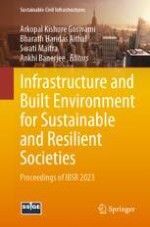This book presents the select proceedings of the Annual Conference on "Infrastructure and Built Environment: Towards Sustainable and Resilient Societies" (IBSR 2023). It covers the latest research and technologies in the area of smart and sustainable built environment for inclusive societies. Various topics covered in this volume are multimodal urban transport, spatial informatics in urban planning, urban morphology, sustainable transport infrastructure development and many more. This book will be useful for researchers and professionals working in the fields of urban mobility, affordable housing, road infrastructure, and spatial informatics.
